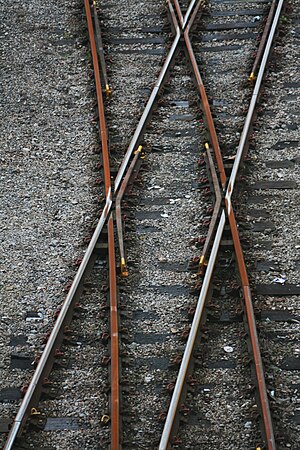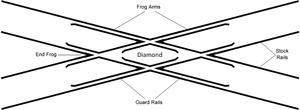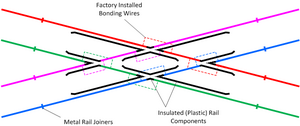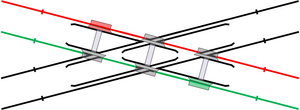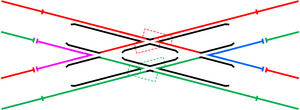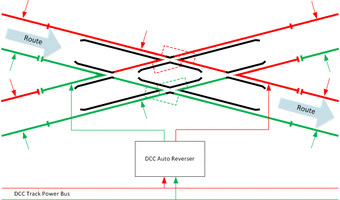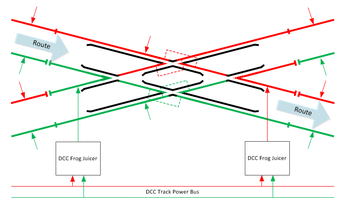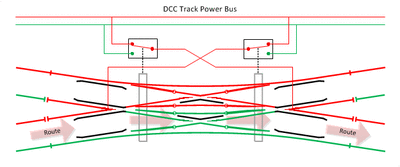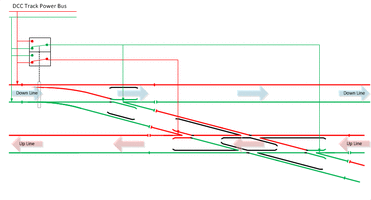Wiring Crossings
|
See the Video. |
Summary:
A railroad crossing allows one track to cross another. There are no means to change the train from one track to another. Terms like Grade Crossing or Level Crossing usually apply to a point where a road crosses the track at grade.
Railroad Crossing
Prototype railroad crossings are manufactured to one of three construction types:
- Bolted rail
- Manganese Steel Insert
- Solid Manganese Steel
Bolted crossings made of three rail construction are used for the heaviest rail service, with two and one rail versions also available for lighter service.
They are available in a number of arrangements, where the crossing would be manufactured for a variety of angles, curved track, and number of crossings. For modelling purposes, the variety of commercial crossing angles is limited, so hand laid trackwork is possible for crossings not available from the hobby shop.
Types of Crossings
There are two types of crossings.
- Crossing: Rails meet at 90º or an equally wide angle
- Frog Type Crossing: The rails meet at a sharp angle, so frogs are incorporated into the design
- Just like a turnout, this type of crossing has frogs where the inner rails meet at an angle but obviously in this case there are multiple frogs. A crossing also has guard (or check) rails just like a turnout to ensure that the wheelsets take the correct route through the frogs. The outer rails are called the frog arms. Frogs outside the crossover are end frogs
Wiring
Overview
Here are some recommendations for wiring crossings on a DCC layout...
- Feed track power to all metal rails in the turnout/crossover.
- Do not rely to on metal rail joiners to feed power to or through crossings.
- Use live frog crossings if possible.
- Feed track power to live frogs using a toggle switch to control the frog's phase.
Illustrations
In any case there will be gaps where the frog arms meet to prevent a short to the adjacent phase.
Dead Frog Crossing
This diagram of the Insulfrog or Dead Frog shows where to feed track power to a typical dead frog crossing. Feed power everywhere an arrow is shown and do not rely on the metal rail joiners, as they do not make reliable electrical joints.
In particular, try to feed power to all of the separate metal rail components in the crossing (except the guard rails). If two components are already electrically bonded with internal wires (usually on the underside) then you only need to feed one of them.
The diagram above shows a diamond crossing with isolated routes (which is fairly typical). This means the two routes are totally electrically isolated and you are free to wire them up how you want:
- Same parallel power district. This is the most common case where the two routes meet again (e.g. at a turnout) without any reversing loop involved. This would make the red and magenta rails common and the green and blue rails common.
- Same power district but reversed. This is what would happen if there was a loop at one or other end of the crossing. This would make the red and blue rails common and the green and magenta rails common. This in itself doesn't make a reversing loop but if it forms part of a reversing loop then an auto reverser would be required to prevent a short where they eventually meet at a turnout.
- Different power districts.
Live Frog Crossing
These can be a bit tricky to wire up because the frogs will only be correct for one route and there are no moving parts to which to attach mechanical frog phase switches.
- Use a DCC Auto Reverser which is dedicated to the frogs of one crossing. One output goes to one frog, the other to the other frog.
- Use two electronic DCC Frog Juicers. Don't be tempted to double-up one juicer, it will work, the frogs always need to be opposite phase.
- Use the turnout motor accessory switches of closely related turnouts to infer the frogs' polarities from the selected route.
For the last case you can also feed the frog power through high wattage resistors or 12V automotive light bulbs to reduce the short circuit current if you accidentally drive a train against the route setting. This will prevent your booster from tripping.
Don't be tempted to only use automotive light bulbs or other Frog Current Limiter techniques for live frog crossings. One route will always be wrong and no better than had you used a dead frog crossing – remember, you were counting on the live frog providing power, now for one route you will get no power from the frog.
An exception to all the above is when one end of the crossing loops back on itself (e.g., in a figure of eight configuration). In this case the live frogs can be hard-wired and will always be correct because the frog rails always match.
Dead Frog Slips
Dead frog slips can be wired up essentially the same as dead frog diamond crossings except that all routes should be in the same power district.
If a reversing loop is involved (one end of the crossing loops back around on itself) then a DCC Auto Reverser will be required for the loop and insulating rail joiners or gapped rails must be used.
Live Frog Slips
Live frog slips can be wired up in a similar manner to live frog crossings as follows:
- Use a DCC Auto Reverser or two DCC Frog Juicers as described above for diamond crossings.
- For double-slips use the crossing's turnout motors' accessory switches to switch the frog polarities as described below (see #Single and Double Slips).
- Single-slips are trickier to wire using accessory contacts because there is one setting of the switch rails which makes it equivalent to a diamond crossing (see #Single and Double Slips).
Frog Switching
Auto Reverser
Regardless of whether the crossing includes a single or double slip, a DCC Auto Reverser can be used to switch the phase of the frogs.
The diagram below shows how to wire up a live frog crossing (e.g., a PECO Electrofrog Diamond Crossing) with an auto reverser feeding the frogs. The lightning bolts represent a train arriving on the other route and causing a short circuit. This auto reverser detects this short and flips the phase to allow the train to proceed.
Note that you want an auto reverser module, not an auto reversing booster. Whilst in theory you could use a booster, it would be a waste to use an entire booster just to power one crossing's frogs.
Frog Juicers
Regardless of whether the crossing includes a single or double slip, two DCC electronic Frog Juicers can be used to control the phase of the frogs.
The diagram below shows how to wire up a live frog crossing (e.g., a Peco Electrofrog Diamond Crossing) with two juicers feeding the frogs. The lightning bolts represent a train arriving on the other route and causing a short circuit, the first short occurs with the entry frog and then a subsequent short occurs on the exit frog.
Examples
Auto Reverser: Wiring a Live Frog Crossing with an Auto Reverser
Frog Juicer: Wiring a Live Frog Crossing with Frog Juicers
A Live Frog Double Slip Crossing with Turnout Motor Frog Switching
Peco Insulfrog Crossing
Wiring Electrofrog Crossings
How to Wire a PECO Diamond with an NCE AR10
PECO Electrofrog in N Scale with Frog Juicer
